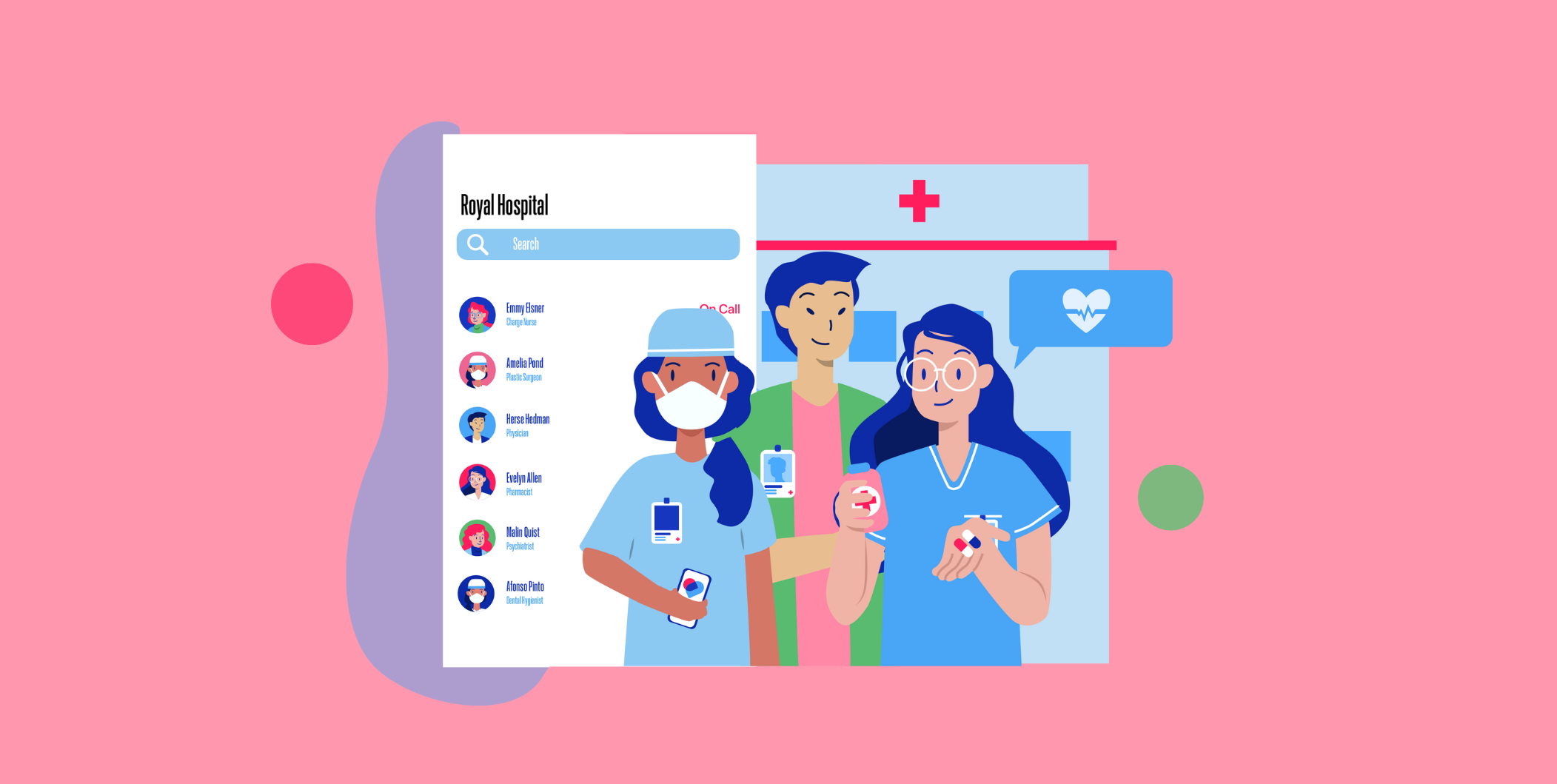Nov 5, 2025
Everything You Need to Know About Secure Messaging in Healthcare
Jul 15, 2024 - Blog
Secure messaging is now fundamental for safe and efficient healthcare communication. It helps healthcare teams collaborate seamlessly and protects sensitive patient information, revolutionizing care delivery.
This guide covers the critical benefits of secure messaging, essential security features, HIPAA compliance, and best practices to ensure patient privacy. Whether you're new to secure messaging or looking to deepen your understanding, this blog provides everything you need in a clear, reliable way.
Why is communication important in the healthcare field?
Communication is crucial in healthcare because it ensures that information flows smoothly between patients, healthcare providers, and support staff. Clear communication helps prevent errors, promotes accurate diagnosis and treatment, and enhances patient outcomes, safety, and satisfaction. When everyone is on the same page, healthcare teams can collaborate effectively to deliver the best possible care.
What is secure messaging in healthcare?
Secure messaging in healthcare involves using digital platforms to exchange sensitive patient information between authorized healthcare professionals. It ensures that messages containing protected health information (PHI) are transmitted and stored securely, complying with regulatory standards like HIPAA to safeguard patient confidentiality.
Related article: The Evolution of Communication in Healthcare Settings
What are the benefits of secure messaging in healthcare?
Secure messaging offers several benefits in healthcare. It enables quick and direct provider communication, enhancing care coordination and decision-making. Reducing reliance on traditional communication methods like phone calls and faxes saves time and improves workflow efficiency.
Additionally, secure messaging platforms support better patient outcomes by enabling timely consultations and reducing communication errors.
How does secure messaging improve communication among healthcare professionals?
Secure messaging improves communication among healthcare professionals by providing a reliable, efficient, and auditable means to exchange patient information. It allows providers to securely send instant messages and clinical photos, share test results, and discuss treatment plans.
With features like read receipts and message priority settings, healthcare teams can prioritize urgent matters and promptly ensure that critical information reaches the right person. This streamlined communication process fosters collaboration, reduces misunderstandings, and ultimately enhances the quality of patient care.
What security features are crucial for secure messaging platforms?
Crucial security features for secure messaging platforms include robust encryption protocols to protect data at rest and in transit, ensuring confidentiality and preventing unauthorized access. Authentication mechanisms rigorously manage platform access, allowing only authorized users to interact securely.
Adherence to HIPAA regulations is also vital, ensuring thorough safeguarding of sensitive patient information and bolstering trust and compliance in healthcare communications.
These features collectively ensure that sensitive healthcare data remains confidential and secure throughout its transmission and storage.
What are the best practices for healthcare professionals using secure messaging?
To enhance security, healthcare professionals should use strong authentication, encrypt messages, verify recipients, avoid texting PHI, and provide regular training. Let’s examine each of these best practices in more detail.
- Understand HIPAA compliance: Familiarize yourself with its requirements and stay updated on all compliance guidelines to understand HIPAA compliance.
- Use encryption: Encryption secures patient information by ensuring all messages are encrypted during transmission and storage, using robust encryption keys and algorithms for enhanced security.
- Verify recipients: Double-check recipient details before sending messages, ensure only authorized recipients receive sensitive information, and use secure messaging platforms with built-in recipient verification features.
- Avoid texting PHI: Use dedicated secure messaging platforms for healthcare communication, and avoid sending PHI through regular SMS or unsecured channels.
- Use strong authentication: Implement two-factor authentication (2FA) or multi-factor authentication (MFA) for secure messaging platforms; use strong, unique passwords and biometrics, and regularly update authentication credentials.
- Provide regular training: Educate staff to identify and mitigate security risks and promote cybersecurity awareness among healthcare professionals.
How is patient privacy maintained with secure messaging?
Secure messaging maintains patient privacy by encrypting messages to ensure they're only accessible to authorized recipients, using secure platforms that comply with strict privacy regulations like HIPAA, and employing features like message expiration and access to controls to limit data exposure–ensuring peace of mind for patients and healthcare providers alike!
Understanding data protection in healthcare
Data protection is essential in healthcare, as it safeguards sensitive patient information. It involves implementing stringent security measures across storage and transmission channels.
Related article: How To Responsibly Share Medical Photos
Protecting data includes using encryption to encode information during transmission and storage, securing access through authentication controls, and adhering to regulatory frameworks like HIPAA to ensure patient confidentiality and trust in healthcare settings.
What is encrypted communication?
Encrypted communication is a method of encoding information to make it unreadable to unauthorized users. In healthcare, this ensures that patient data remains confidential and secure during transmission between healthcare providers and across digital platforms.
Encryption uses algorithms to scramble data into a format that can only be deciphered by those with the correct decryption key, thereby protecting sensitive information from interception or unauthorized access.
What role does encryption play in securing healthcare messages?
Encryption plays a crucial role in healthcare by protecting the confidentiality and integrity of messages containing sensitive patient information. It ensures that healthcare messages are transmitted securely, preventing unauthorized interception or access.
By encrypting data both in transit and at rest, healthcare organizations comply with regulatory requirements such as HIPAA, safeguard patient privacy, and maintain the trust of patients and stakeholders in their commitment to data security.
What are the requirements for secure messaging in healthcare?
Secure messaging requirements in healthcare include implementing robust security measures such as encryption for confidentiality, ensuring HIPAA compliance, restricting data access with access controls, using features like message expiration for data protection, and supporting secure authentication methods to maintain communication integrity and patient privacy.
What is HIPAA?
HIPAA is the Health Insurance Portability and Accountability Act, which aims to set standards for protecting sensitive patient health information. It regulates how healthcare providers, insurers, and business associates handle and safeguard this information to ensure patient privacy and confidentiality.
Related article: The Ultimate Guide To HIPAA Compliance
What is illegal under HIPAA?
Under HIPAA, disclosing or accessing protected health information (PHI) without authorization is illegal. That includes sharing PHI with unauthorized individuals, failing to secure PHI, and not notifying patients of their privacy rights.
What is the most secure communication?
The most secure communication typically involves end-to-end encrypted methods that prevent unauthorized access. That includes using secure messaging platforms that encrypt data in transit and at rest, ensuring only authorized recipients can access the information.
Is there anything more secure than Signal?
While Signal offers security features such as end-to-end encryption and open-source transparency, newer messaging solutions now surpass security, user privacy, and overall performance. These modern platforms integrate advanced encryption, robust authentication, and user-friendly interfaces, meeting the evolving needs of secure communication.
What are the most secure ways to message in healthcare?
The most secure ways to message in healthcare involve using dedicated secure messaging platforms, encrypted email services, and Electronic Health Record (EHR) chat features that prioritize patient data confidentiality and compliance with privacy regulations.
1. Secure messaging platforms
What are secure messaging platforms? Secure messaging platforms are digital tools that facilitate confidential communication among healthcare professionals. They employ end-to-end encryption and authentication protocols to safeguard patient information from unauthorized access and ensure compliance with healthcare privacy regulations.
Related article: Debunking 6 Popular Myths in Healthcare Communication
Pros: Secure messaging platforms enable confidential communication among healthcare professionals with robust encryption, ensuring HIPAA compliance. They enhance collaboration and decision-making for improved patient care outcomes and are user-friendly, promoting engagement among care teams.
Cons: As a modern tool, some healthcare professionals may need to become more familiar with secure messaging platforms, leading to reluctance to adopt new technologies. They also require regular cybersecurity maintenance.
2. Email services
What are email services? Email services utilize encryption techniques to secure emails containing sensitive patient information. These services ensure that only authorized recipients can access and decipher the encrypted messages, enhancing data privacy and security in healthcare communications.
Pros: Email services securely transmit sensitive patient data, ensuring compliance with HIPAA. They integrate well with existing systems, facilitating ease of use for healthcare professionals.
Cons: Using email for patient communication under HIPAA requires meticulous steps like verifying address accuracy, confirming addresses, and establishing agreements with third-party providers, which can be complex and resource-intensive to maintain compliance and ensure patient data security.
3. EHR chat features
What are EHR chat features? EHR chat features are communication functionalities embedded within Electronic Health Record (EHR) systems, allowing healthcare providers to securely discuss patient cases and exchange information within the EHR environment. These features streamline communication while maintaining patient data security and confidentiality.
Pros: EHR chat features are readily available for most healthcare providers, as they commonly integrate with their pre-existing Electronic Health Record system.
Cons: They're often limited to internal users, requiring customization for specific workflows and careful configuration. They are usually clunky and lack robustness, discouraging users from using this feature altogether.
The best secure messaging platform for healthcare
Celo stands out as the best secure messaging platform for healthcare. It is renowned for its HIPAA compliance, user-friendly interface, and robust feature set tailored specifically for healthcare professionals. It offers a comprehensive suite of tools to enhance team collaboration and patient care coordination.
Beyond its security and usability, Celo is cost-effective, making it accessible to healthcare organizations of all sizes. By facilitating seamless communication and improving team engagement, Celo ensures compliance with stringent healthcare regulations and enhances overall efficiency and quality of care delivery.
To book a demonstration of Celo, click here.
What are the challenges in adopting secure messaging in healthcare?
The challenges in adopting secure messaging in healthcare include ensuring HIPAA compliance, overcoming resistance to new technology among staff, integrating with existing IT systems, managing security risks, and addressing usability concerns while maintaining efficient workflow.
How can secure messaging integrate with existing healthcare IT systems?
Secure messaging can integrate with healthcare IT systems through interoperability standards like HL7 and FHIR. This integration ensures seamless communication between different platforms and allows for the secure exchange of patient information while maintaining compliance with regulatory requirements like HIPAA.
Additionally, APIs and middleware solutions can facilitate data exchange and streamline workflows, enhancing overall healthcare communication and collaboration efficiency.
How to implement secure messaging in healthcare
Implementing secure messaging in healthcare requires selecting a HIPAA-compliant platform, training staff on protocols, integrating with existing systems and ensuring strong security measures. Embrace these advancements in healthcare technology to enhance team collaboration and patient outcomes starting today!
About the Author:

Head of Marketing at Celo
Remy is a passionate and creative marketer at Celo Health, a leading company in the healthcare technology sector. As Head of Marketing, Remy plays a vital role in developing and implementing marketing strategies that highlight Celo Health's cutting-edge solutions and inform a diverse audience about the importance of secure technology in healthcare.


